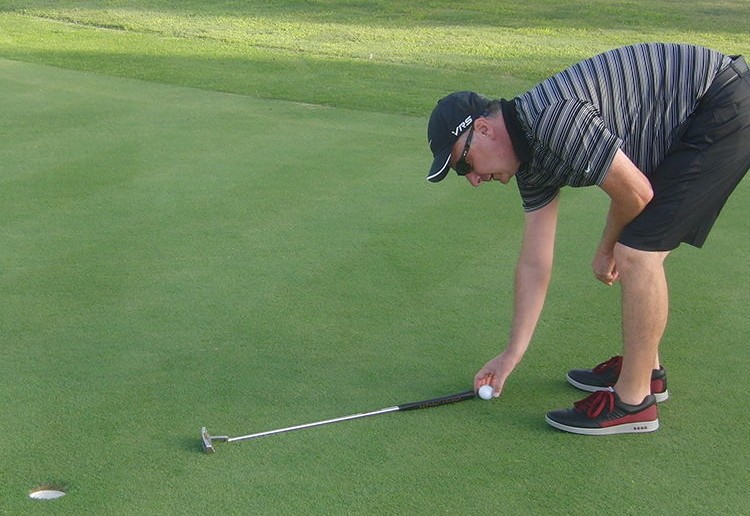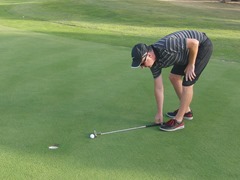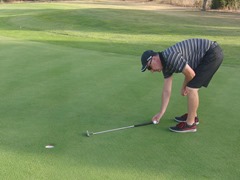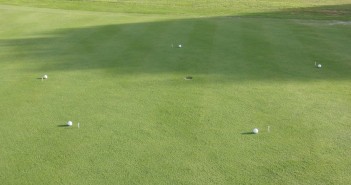Most golfers don’t realise it, but one of the quickest ways to lower your scores is to improve your ability to avoid three-putting when faced with longer putts.
This applies at every level of the game. Tiger Woods at his best won 45% of all the tournaments he played in – this is an astonishing statistic, the great Jack Nicklaus won 12% of his tournaments against (we’d argue) inferior competition. But according to Tiger’s caddie at the time, Steve Williams, who kept detailed statistics, if Tiger hadn’t three-putted he would have won 85% of the time!
Your chances of three-putting increase dramatically when putts get longer than about 30’ (9m).
This 30’ distance is like a mysterious unseen barrier. Putts tend to get gradually more difficult the further we get from the hole, and then suddenly jump in difficulty, and become a lot more costly, above 30’. From 25’, you’re very unlikely to make the putt, but you’ll more than likely get down in two. From 30’ and above, you’re suddenly likely to waste a stroke by three-putting.
There are several reasons why golfers three-putt from further than 30’:
- You don’t practice lag putting.
- You don’t think you have a chance of making it, so you don’t pay it enough attention – you just try to “hit it close”, without really deciding where “close” is and how the ball will get there.
- You don’t pay proper attention when you misjudge a long putt. We all watch very closely when the putt looks like it might be close, but when it’s obviously going to miss we tend to look away in disgust. This is a mistake, the ball is giving you a lot of information about how your second putt might behave as it slows down nearer the hole, and ignoring this information will damage your chances of getting down in two.
- Greens are never perfect, and the longer the ball is rolling, the more likely it is to be deflected by an unnoticed spike mark or piece of detritus, or cumulatively by many smaller imperfections.
- Greens are variable along the length of a long putt, they are likely to have multiple breaks and the grain will change direction relative to the roll.
- The longer that the ball is in motion, the more likely it is to be affected by the wind, and in gusty conditions this is unpredictable.
Three-putts not only waste strokes, but they can also cause golfers to become emotional, angry, and frustrated, potentially wrecking the next hole, too.
Golf isn’t fair, but it’s the game that you love to play, so you really do need to learn to get over it!
The “Golf Isn’t Fair!” game is designed to improve your ability, and your attitude, from lag-putt range in a number of ways:
- It will improve your ability to read longer, more complex putts.
- It gives you practice at maintaining your rhythm with a longer stroke.
- It will develop your touch and feel – your subconscious correlation between stroke length and putt speed. Great lag putting is all about “remembering” what a 46’ putt feels like.
- It forces you to pay attention, especially to the all-important last few feet of each putt’s roll.
- You’ll need to consider where you will leave the ball much more carefully – you’ll be punished severely for leaving yourself a downhill second putt.
- It trains you to take a more positive, stoic attitude to missing, even when it’s not your fault.
How to Play “Golf Isn’t Fair!”
On the practice green, choose a random hole and play putts from 30’, 40’ and 50’ (9, 12 and 15m).
It is important that you perform your full pre- and post-shot routine for every putt. Go through your green reading process, take your time to visualise the stroke, practise your quiet eye technique, try the right amount and react to the target. Use your post-shot routine to actively build your self-image and learn from your mistakes.
If (when) you miss a putt, you must draw it back 34” (86cm, one standard putter length) from the point where the ball comes to rest, directly away from the hole, and play it from there – see Figures 1 to 3. Keep playing until you hole the putt, taking a 34” penalty every time you miss.
We did warn you that it wasn’t fair!
Repeat the process another three times, again from 30’, 40’ and 50’, but to a different hole and with a different predominant break – for example: 3 downhill right-to-left putts and 3 uphill left-to-right.
Record the total number of strokes required to sink the six balls. Try to find different putts every time you play – don’t stick with what you know, you won’t get that luxury out on the course.
It’s highly unlikely that you’ll ever score 6, and a score of 12 is very good putting. Any score higher than 18 is poor, indicating that you have an opportunity to significantly improve your scores by working on your lag putting.
This is a difficult game, but it should be a lot of fun. If you find it frustrating, then you need to work on your attitude – it’s costing you strokes! Being a great putter is about how you deal with your misses, every bit as much as your swing mechanics.
You can also turn this into a great two-player match play game.
Toss a coin to see who goes first on the first hole. You win the hole by making the least number of putts. The winner has the (dubious) honour on the next hole. Best of six.
This game forms part of the Golf Loopy Putt like a Champion series, the sensational new putting game improvement system that will help you to improve every aspect of your performance on the greens. The improvements will be dramatic, and they will be permanent.







